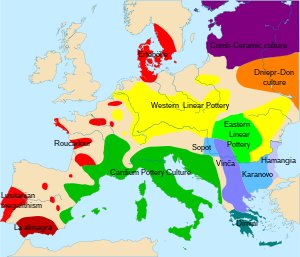Dnepr-Don culture
| Prehistoric cultures of Russia | |
| Mesolithic | |
| Kunda culture | 7400-6000 BC Chr. |
| Neolithic | |
| Bug Dniester culture | 6500-5000 BC Chr. |
| Dnepr-Don culture | 5000-4000 BC Chr. |
| Sredny Stog culture | 4500-3500 BC Chr. |
| Ekaterininka culture | 4300-3700 BC Chr. |
| Fatyanovo culture | around 2500 BC Chr. |
| Copper Age | |
| North Caspian culture | |
| Spa culture | 5000-3000 BC Chr. |
| Samara culture | around 5000 BC Chr. |
| Chwalynsk culture | 5000-4500 BC Chr. |
| Botai culture | 3700-3100 BC Chr. |
| Yamnaya culture | 3600-2300 BC Chr. |
| Afanassjewo culture | 3500-2500 BC Chr. |
| Usatovo culture | 3300-3200 BC Chr. |
| Glaskovo culture | 3200-2400 BC Chr. |
| Bronze age | |
| Poltavka culture | 2700-2100 BC Chr. |
| Potapovka culture | 2500-2000 BC Chr. |
| Catacomb tomb culture | 2500-2000 BC Chr. |
| Abashevo culture | 2500-1800 BC Chr. |
| Sintashta culture | 2100-1800 BC Chr. |
| Okunew culture | around 2000 BC Chr. |
| Samus culture | around 2000 BC Chr. |
| Andronovo culture | 2000-1200 BC Chr. |
| Susgun culture | around 1700 BC Chr. |
| Srubna culture | 1600-1200 BC Chr. |
| Colchis culture | 1700-600 BC Chr. |
| Begasy Dandybai culture | around 1300 BC Chr. |
| Karassuk culture | around 1200 BC Chr. |
| Ust-mil culture | around 1200–500 BC Chr. |
| Koban culture | 1200-400 BC Chr. |
| Irmen culture | 1200-400 BC Chr. |
| Late corporate culture | around 1000 BC Chr. |
| Plate burial culture | around 1300–300 BC Chr. |
| Aldy Bel culture | 900-700 BC Chr. |
| Iron age | |
| Baitowo culture | |
| Tagar culture | 900-300 BC Chr. |
| Nosilowo group | 900-600 BC Chr. |
| Ananino culture | 800-300 BC Chr. |
| Tasmola culture | 700-300 BC Chr. |
| Gorokhovo culture | 600-200 BC Chr. |
| Sagly bashi culture | 500-300 BC Chr. |
| Jessik Beschsatyr culture | 500-300 BC Chr. |
| Pazyryk level | 500-300 BC Chr. |
| Sargat culture | 500 BC Chr. – 400 AD |
| Kulaika culture | 400 BC Chr. – 400 AD |
| Tes level | 300 BC Chr. – 100 AD |
| Shurmak culture | 200 BC Chr. – 200 AD |
| Tashtyk culture | 100–600 AD |
| Chernyakhov culture | AD 200–500 |
The two-tier Dnepr-Donets culture is an archaeological culture of the 5th millennium BC. In Eastern Europe north of the Black Sea between Dnepr and Donets . There are parallels to the approximately simultaneous Samara culture . The Dnepr-Don culture is followed by the early Jamna culture .
Economy
Dnepr-Donets culture I
The Dnepr-Donets-I culture was a hunter-gatherer culture with ceramics. Anthony carefully dates them between 5800 and 5200 BC. BC and at the same time as the Bug-Dniester culture .
Dnepr-Donets culture II
The range from 5200-5000 to 4400-4200 (confidence intervals of the radiocarbon dating) v. The subsequent Dnepr-Donets-II culture was a Neolithic culture of the Eastern European Copper Age , called the Eneolithic there.
Burials
Burials were made in grave pits where the buried were sprinkled with ocher. In addition to individual graves, larger graves with burials placed one after the other were common. The habitus is described as typical of people of European descent.
Ceramics
The early use of typical pointed-bottom transport ceramics resembles the behavior of other Mesolithic cultures in the periphery of Neolithic cultures. Other examples of this can be found in the Swifterbant culture in the Netherlands, Ellerbek, the Ertebølle culture in northern Germany and Scandinavia, the ceramics of the “ceramic mesolithic” of Belgium and northern France (including non-linear ceramics such as that from La Hoguette, Bliquy , Villeneuve-Saint-Germain) and in the Roucedour culture in south-west France.

literature
- James P. Mallory : Dnieper-Donets Culture. In: James P. Mallory, Douglas Q. Adams (Eds.): Encyclopedia of Indo-European Culture. Fitzroy Dearborn, London et al. 1997, ISBN 1-88496-498-2 , pp. 166-168.